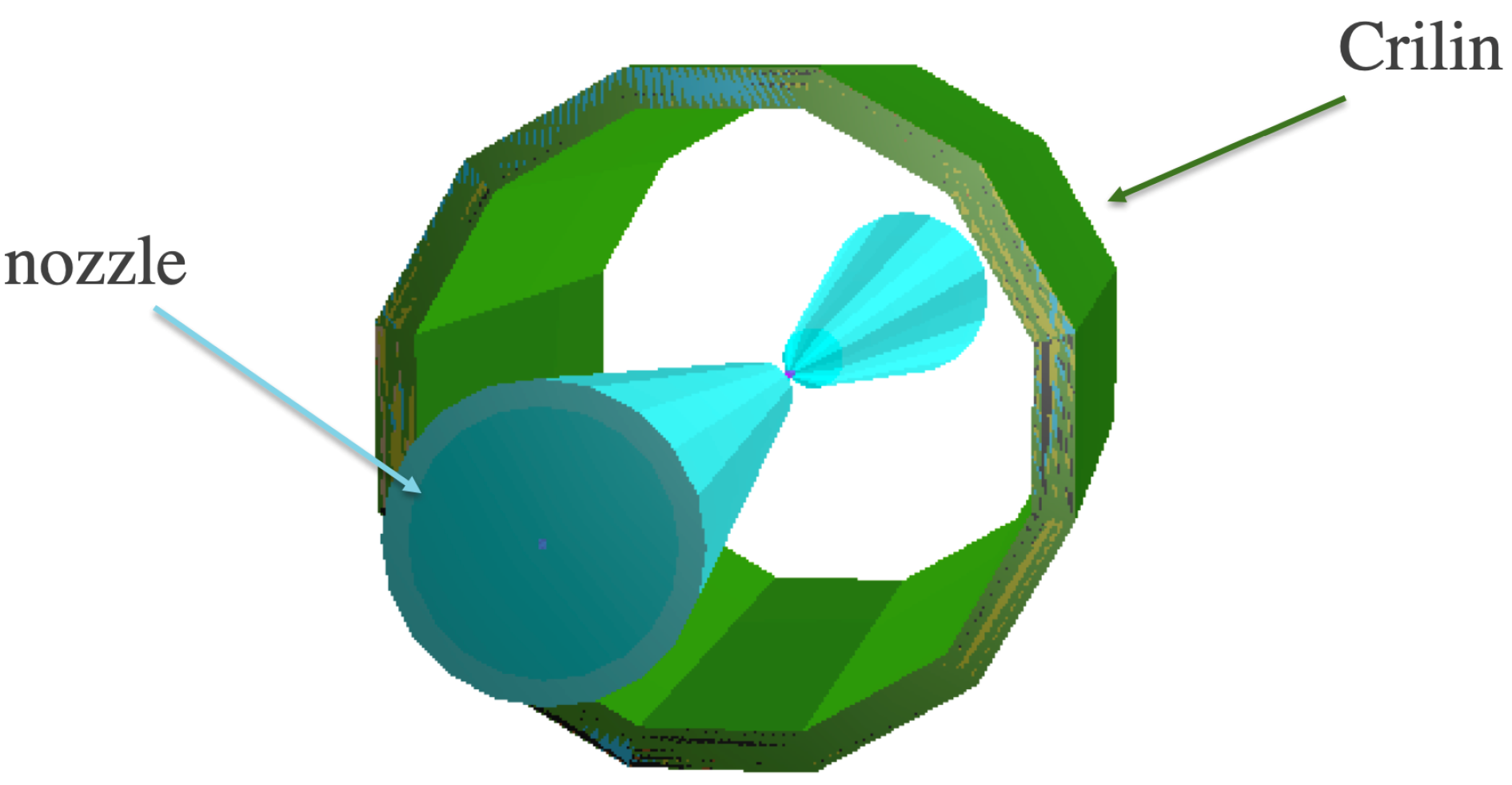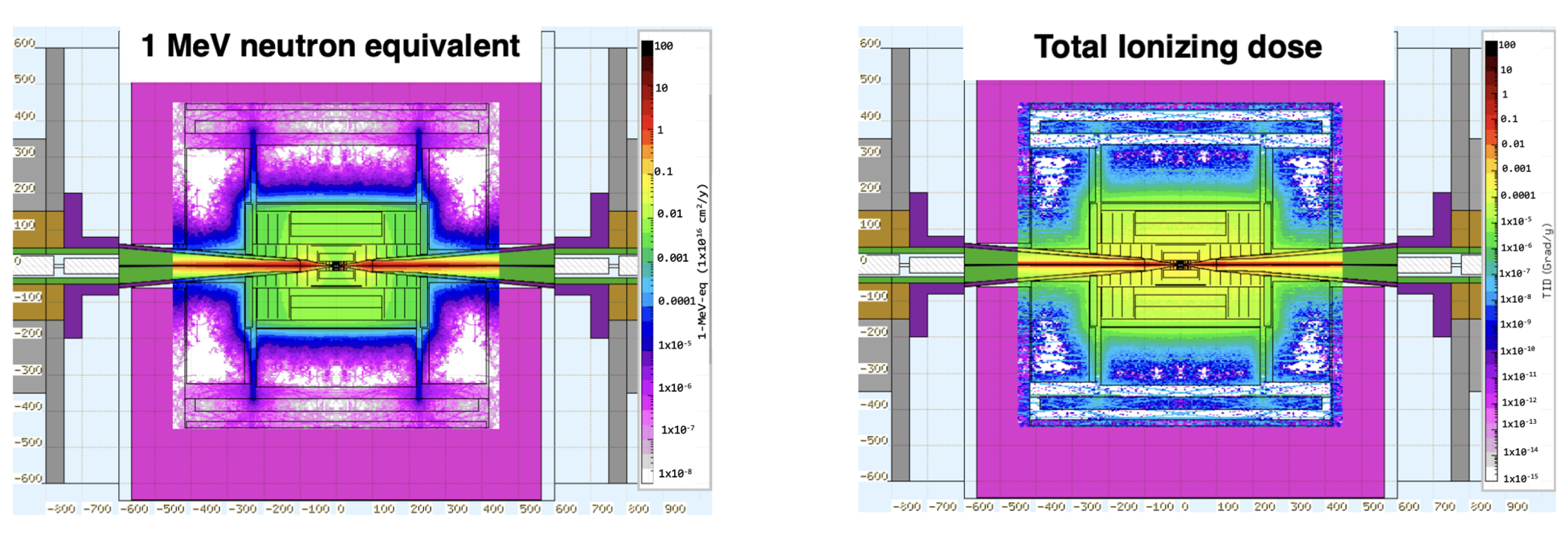Crilin: A Semi-Homogeneous Calorimeter for a Future Muon Collider
Abstract
1. Introduction
- High granularity to reduce the overlap of BIB particles in the same calorimeter cell.
- Good timing resolution can be utilised to reduce the out-of-time component of the BIB (Figure 1-left). A time resolution of about = 80 ps should be achieved.
- Longitudinal segmentation since the signal energy profile in the longitudinal direction is different from the BIB one, hence a segmentation of the calorimeter can help distinguishing the signal showers from the fake showers produced by the BIB (Figure 1-right).
- Good energy resolution, 10%/ in the ECAL system is expected to be enough to obtain good physics performance.
2. The Crilin Calorimeter
- As the Cherenkov light production in PbF is instantaneous with respect to the particle passage this leads to an inherently fast detector response and excellent timing resolution.
- Narrow signals hence an excellent ability to temporally resolve close events at high rate.
- A good light collection that enables a fine energy resolution throughout the whole dynamic range.
- Resistance to radiation.
- Fine granularity that scales with the SiPMs dimensions.
Radiation Hardness and Crystals Characterisation
3. The Crilin Prototype
FEE and SiPMs Tests
- Constant laser pulse amplitude (adjusted in order to have signals with 1 V peak amplitude) and fixed 40 Gsps sample rate, while laser repetition rate was increased from 50 kHz up to 5 MHz.
- Fixed laser amplitude (as before) and fixed 100 kHz laser repetition rate, while the oscilloscope sample rate was swept in the range 2.5 to 40 Gsps.
- Fixed laser repetition rate and sampling frequency, while the waveform peak amplitude was swept over the FEE dynamic range.
4. Conclusions
Author Contributions
Funding
Data Availability Statement
Acknowledgments
Conflicts of Interest
References
- Sestini, L.; Sarra, I.; Andreetto, P.; Gianelle, A.; Lucchesi, D.; Buonincontri, L.; Zuliani, D.; Casarsa, M.; Bartosik, N.; Pastrone, N.; et al. Design a calorimeter system for the Muon Collider experiment. PoS 2022, EPS-HEP2021, 776. [Google Scholar] [CrossRef]
- Bartosik, N.; Krizka, K.; Griso, S.P.; Aimè, C.; Apyan, A.; Mahmoud, M.A.; Bertolin, A.; Braghieri, A.; Buonincontri, L.; Calzaferri, S.; et al. Simulated Detector Performance at the Muon Collider. arXiv 2022, arXiv:2203.07964. [Google Scholar] [CrossRef]
- Collamati, F.; Curatolo, C.; Lucchesi, D.; Mereghetti, A.; Mokhov, N.; Palmer, M.; Sala, P. Advanced assessment of beam-induced background at a muon collider. J. Instrum. 2021, 16, P11009. [Google Scholar] [CrossRef]
- Zhu, R.; Ma, D.; Newman, H.; Woody, C.; Kierstead, J.; Stoll, S.; Levy, P. A study on the properties of lead tungstate crystals. Nucl. Instrum. Methods Phys. Res. Sect. A Accel. Spectrometers Detect. Assoc. Equip. 1996, 376, 319–334. [Google Scholar] [CrossRef]
- Cemmi, A.; Colangeli, A.; D’orsi, B.; Sarcina, I.D.; Diociaiuti, E.; Fiore, S.; Paesani, D.; Pillon, M.; Saputi, A.; Sarra, I.; et al. Radiation study of Lead Fluoride crystals. J. Instrum. 2022, 17, T05015. [Google Scholar] [CrossRef]
- Hamamatsu SiPMs Datasheet. Available online: https://www.hamamatsu.com/content/dam/hamamatsu-photonics/sites/documents/99_SALES_LIBRARY/ssd/s14160-1310ps_etc_kapd1070e.pdf (accessed on 7 October 2022).










Publisher’s Note: MDPI stays neutral with regard to jurisdictional claims in published maps and institutional affiliations. |
© 2022 by the authors. Licensee MDPI, Basel, Switzerland. This article is an open access article distributed under the terms and conditions of the Creative Commons Attribution (CC BY) license (https://creativecommons.org/licenses/by/4.0/).
Share and Cite
Ceravolo, S.; Colao, F.; Curatolo, C.; Di Meco, E.; Diociaiuti, E.; Lucchesi, D.; Paesani, D.; Pastrone, N.; Pezzullo, G.; Saputi, A.; et al. Crilin: A Semi-Homogeneous Calorimeter for a Future Muon Collider. Instruments 2022, 6, 62. https://doi.org/10.3390/instruments6040062
Ceravolo S, Colao F, Curatolo C, Di Meco E, Diociaiuti E, Lucchesi D, Paesani D, Pastrone N, Pezzullo G, Saputi A, et al. Crilin: A Semi-Homogeneous Calorimeter for a Future Muon Collider. Instruments. 2022; 6(4):62. https://doi.org/10.3390/instruments6040062
Chicago/Turabian StyleCeravolo, Sergio, Francesco Colao, Camilla Curatolo, Elisa Di Meco, Eleonora Diociaiuti, Donatella Lucchesi, Daniele Paesani, Nadia Pastrone, Gianantonio Pezzullo, Alessandro Saputi, and et al. 2022. "Crilin: A Semi-Homogeneous Calorimeter for a Future Muon Collider" Instruments 6, no. 4: 62. https://doi.org/10.3390/instruments6040062
APA StyleCeravolo, S., Colao, F., Curatolo, C., Di Meco, E., Diociaiuti, E., Lucchesi, D., Paesani, D., Pastrone, N., Pezzullo, G., Saputi, A., Sarra, I., Sestini, L., & Tagnani, D. (2022). Crilin: A Semi-Homogeneous Calorimeter for a Future Muon Collider. Instruments, 6(4), 62. https://doi.org/10.3390/instruments6040062







